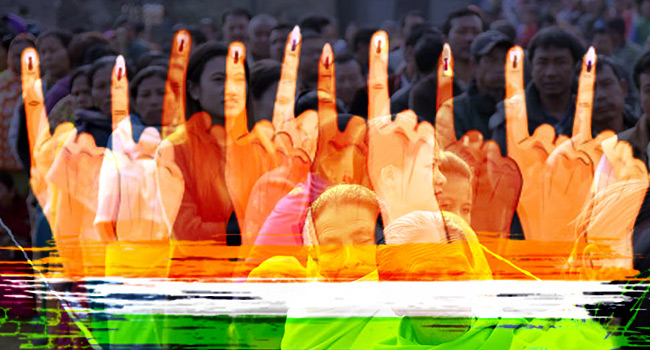India has an asymmetric federal government, with elected officials at the federal, state and local levels. At the national level, the head of government, the Prime minister, is elected by the members of Lok Sabha, the lower house of the parliament of India. All members of Lok Sabha except two, who can be nominated by the president of India, are directly elected through general elections which take place every five years, in normal circumstances, by universal adult suffrage. Members of Rajya Sabha, the upper house of Indian parliament, are elected by elected members of the legislative assemblies of states and Electoral college for Union Territories of India.
The size of the huge electorate mandates that elections be conducted in a number of phases (there were four phases in 2004 General Elections and five phases in 2009 general election). It involves a number of step-by-step processes from the announcement of election dates by the Election Commission of India, which brings into force the ‘model code of conduct’ for the political parties, to the announcement of results and submission of the list of successful candidates to the executive head of the state or the centre. The submission of results marks the end of the election process, thereby paving the way for the formation of the new government.
Read Also: Centre’s Approval for NIMZ in Medak
The Parliament of India comprises the head of state and the two houses which are the legislature. The president of India is elected for a five-year term by an electoral college consisting of members of federal and state legislatures.
The House of the People (Lok Sabha) represents citizens of India (as envisaged by the Constitution of India, currently the members of Lok Sabha are 545, out of which 543 are elected for the five-year term and two members represent the Anglo-Indian community). The 545 members are elected under the plurality electoral system. Council of States (Rajya Sabha) has 245 members, 233 members elected for a six-year term, with one-third retiring every two years. The members are indirectly elected, this being achieved by the votes of legislators in the state and union (federal) territories. The elected members are chosen under the system of proportional representation by means of theSingle Transferable Vote. The twelve nominated members are usually an eclectic mix of eminent artists (including actors), scientists, jurists, sportspersons, businessmen and journalists and common people.
Electoral Process in India takes at least a month for state assembly elections with the duration increasing further for the General Elections. Publishing of electoral rolls is a key process that happens before the elections and is vital for the conduct of elections in India. The Indian Constitution sets the eligibility of an individual for voting. Any person who is a citizen of India and above 18 years of age is eligible to enroll as a voter in the electoral rolls. It is the responsibility of the eligible voters to enroll their names. Normally, voter registrations are allowed latest one week prior to the last date for nomination of candidates.
In recent polls of 2014 Bharatiya Janata Party has achieved the simple majority on its own with securing 282 seats and their alliance NDA has secured 335 seats. Narendra Modi widely recognized as a strong leader with economic developmental focus is now the prime minister.
Must Read: Vision set forth in the Indian Constitution
On 14 August 2013, the Government of India amended the elections rules to permit the use the Voter-verified paper audit trail (VVPAT) system. The first election to implement the new system was a by-election held in the 51 Noksen Assembly Constituency of Nagaland. Voter-verified paper audit trail (VVPAT) system is introduced in 8 of 543 parliamentary constituencies as a pilot project in Indian general election, 2014. VVPAT is implemented in Lucknow, Gandhinagar, Bangalore South, Chennai Central, Jadavpur,Raipur, Patna Sahib and Mizoram constituencies. Generated slip tells voter to which party or candidate vote has been given and also includes the name of voter, constituency and polling booth.
At first before the elections the dates of nomination, polling and counting take place. The model code of conduct comes in force from the day the dates are announced. No party is allowed to use the government resources for campaigning. The code of conduct stipulates that campaigning be stopped 48 hours prior to the end of polling.
“None of the above” is a proposed voting option in India that would allow voters who support none of the candidates available to them to register an official vote of “none of the above”, which is not currently allowed under India election regulation. The Election Commission of India told the Supreme Court in 2009 that it wished to offer the voter a None of the above buttons on voting machines; the government, however, has generally opposed this option.
In the 2014 general election, NOTA polled 1.1% of the votes, counting to over 6,000,000.
Recently various opposition parties have raised questions regarding EVM and demanding an increased number of counting from VVPAT, some regional parties have demanded to reintroduce old paper ballot system.
Government and Election Commission are exploring options to reduce the number of election years in the country by clubbing state elections and if possible national general election with state elections at same time.
Don’t Miss:








